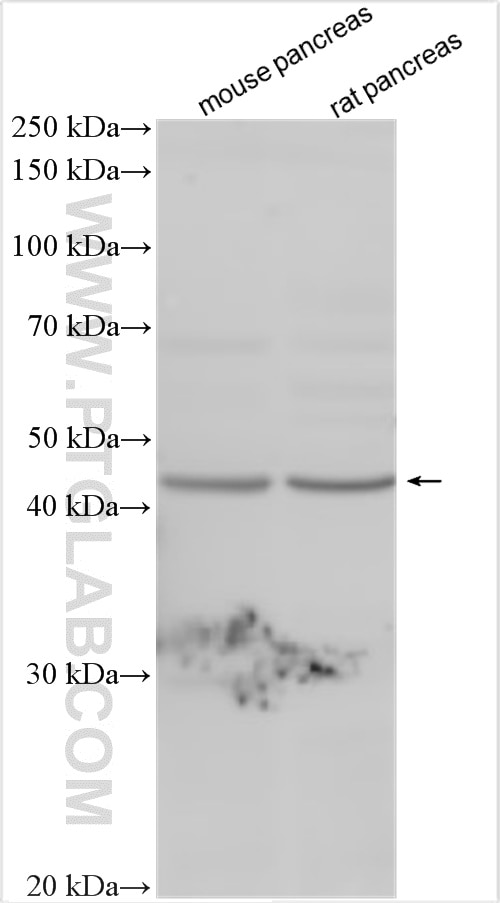Tested Applications
| Positive WB detected in | mouse pancreas tissue, rat pancreas tissue |
Recommended dilution
| Application | Dilution |
|---|---|
| Western Blot (WB) | WB : 1:500-1:1000 |
| It is recommended that this reagent should be titrated in each testing system to obtain optimal results. | |
| Sample-dependent, Check data in validation data gallery. | |
Product Information
17962-1-AP targets OPCML in WB, ELISA applications and shows reactivity with human, mouse, rat samples.
| Tested Reactivity | human, mouse, rat |
| Host / Isotype | Rabbit / IgG |
| Class | Polyclonal |
| Type | Antibody |
| Immunogen |
CatNo: Ag12560 Product name: Recombinant human OPCML protein Source: e coli.-derived, PGEX-4T Tag: GST Domain: 27-345 aa of BC074773 Sequence: TGVPVRSGDATFPKAMDNVTVRQGESATLRCTIDDRVTRVAWLNRSTILYAGNDKWSIDPRVIILVNTPTQYSIMIQNVDVYDEGPYTCSVQTDNHPKTSRVHLIVQVPPQIMNISSDITVNEGSSVTLLCLAIGRPEPTVTWRHLSVKEGQGFVSEDEYLEISDIKRDQSGEYECSALNDVAAPDVRKVKITVNYPPYISKAKNTGVSVGQKGILSCEASAVPMAEFQWFKEETRLATGLDGMRIENKGRMSTLTFFNVSEKDYGNYTCVATNKLGNTNASITLYGPGAVIDGVNSASRALACLWLSGTLLAHFFIKF Predict reactive species |
| Full Name | opioid binding protein/cell adhesion molecule-like |
| Calculated Molecular Weight | 345 aa, 38 kDa |
| Observed Molecular Weight | 45 kDa |
| GenBank Accession Number | BC074773 |
| Gene Symbol | OPCML |
| Gene ID (NCBI) | 4978 |
| RRID | AB_2935445 |
| Conjugate | Unconjugated |
| Form | Liquid |
| Purification Method | Antigen affinity purification |
| UNIPROT ID | Q14982 |
| Storage Buffer | PBS with 0.02% sodium azide and 50% glycerol, pH 7.3. |
| Storage Conditions | Store at -20°C. Stable for one year after shipment. Aliquoting is unnecessary for -20oC storage. 20ul sizes contain 0.1% BSA. |
Background Information
OPCML, also called opioid-binding cell adhesion molecule (OBCAM), belongs to the IgLON limbic system-associated membrane protein (LSAMP, OPCML/OBCAM, neurotrimin) family of IgG domain containing glycosylphosphatidylinositol-anchored cell adhesion molecules. Originally isolated from brain, OPCMLis also expressed in stomach, ovary, heart, placenta, testis, kidney, liver, pancreas and colon. OPCML has been identified as a tumour suppressor, which inhibited tumor growth in some cancers including ovarian cancer, lung cancer and prostate cancer (PMID: 19176311; 28407749).
Protocols
| Product Specific Protocols | |
|---|---|
| WB protocol for OPCML antibody 17962-1-AP | Download protocol |
| Standard Protocols | |
|---|---|
| Click here to view our Standard Protocols |




